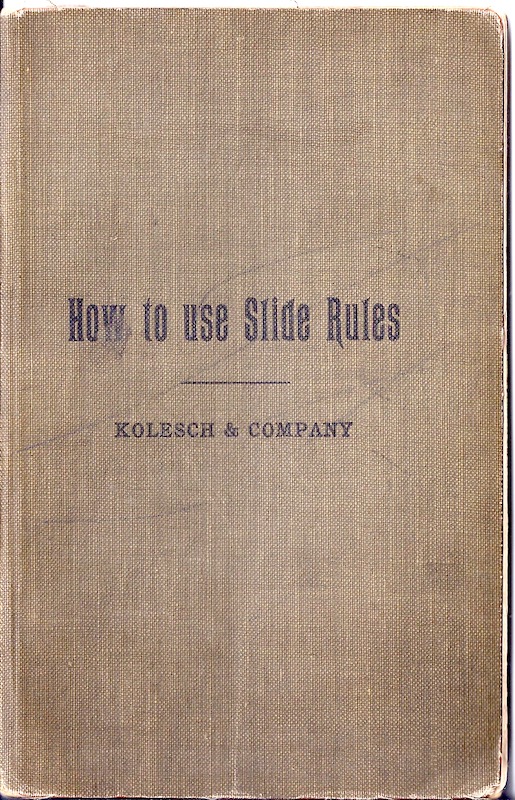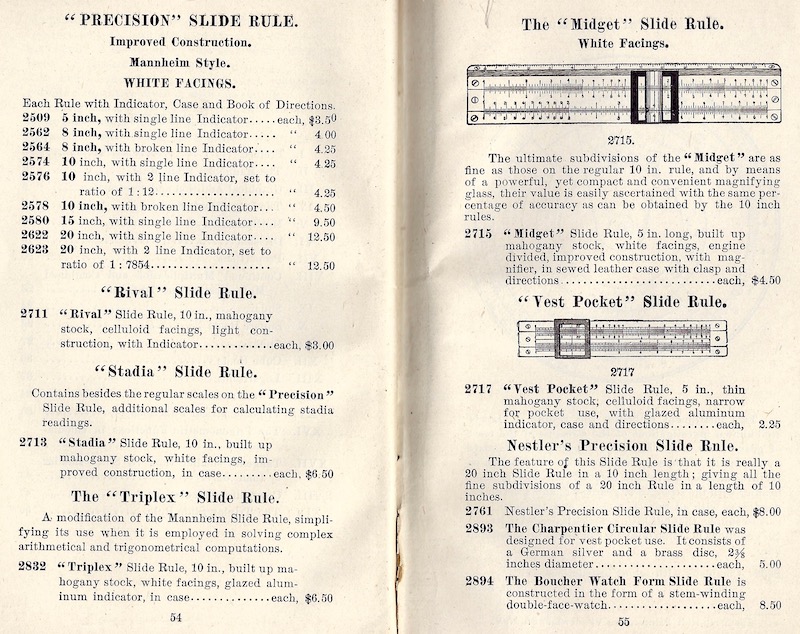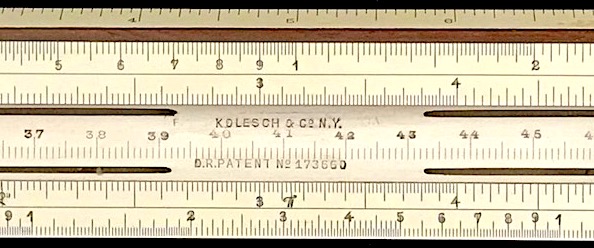8.24 Kolesch Rules
Latest Update: 2024 Jul 10
Originally posted: 2023 Oct 25
In my quest to develop a collection of Post Versalogs and their accompanying instruction manuals (see the discussion in Chicago Rules), I came across a Versalog II for only $10 online which fit the bill, so to speak. It also came with a slide rule instruction manual from 1908. Only the cover of the book was shown in a small image in the ad, but it was clearly titled, How To Use Slide Rules. When I received the package I almost immediately became more interested in this second item than I had been in the original item. The book was written by D. Petri Palmedo in 1907, and published in 1908. Throughout the first 20 pages or so, the book was averaging almost one figure per page, and included numerous tables and examples of the standard calculations that could be performed using a Mannheim-style slide rule. I also enjoyed seeing various sentences and phrases such as, “If the ultimate group of figures or cyphers consists of three places, …”, for obvious reasons. But the last chapter, which starts on page 50, has the curious title “The Triplex Slide Rule”, a slide rule I had not heard of, and thus a title that definitely piqued my interest.
The book was published by Kolesch & Co., New York, and until I received the book I had not realized that Kolesch was a company that sold slide rules in the early 1900s. The last three pages of the book – pp. 53-56 – provided lists of the slide rules being sold by the company in 1908. The lists show a Nestler slide rule, the Charpentier circular slide rule, the Boucher “watch-form” slide rule, as well as a Barth’s Gear Slide Rule being offered. But in addition were standard Mannheim slide rules in lengths of 5, 8, 10, 15, and 20 inches. They also noted a stadia rule and one that they were calling the Triplex, each going for $6.50 (about $231 in 2023 dollars). Only the Boucher and the 15 and 20 inch Mannheims cost more.



Cover, Contents, and Ads found in the 1908 Kolesch book.
Drawings shown in the book have slide rules with pins or screws at the ends of the stock and slide, reminiscent of a Nestler design but, other than the single Nestler slide rule identified in the price list at the back of the book, Nestler is not mentioned anywhere within the text. The introductory paragraphs in the book do, however, refer to “German silver screws” in their higher-end slide rules, which were being used by Nestler at the time.
Soon after receiving the book I was able to find a Kolesch slide rule for sale on eBay. They do not appear to be very common; a quick search on Rod Lovett’s search page shows an average of about 1 per year has been sold on eBay over the past 10 years, and only about 2-3 per year during the 10 years prior. But the one I found (which, of course, I was searching for) was a Triplex. Upon checking out on eBay, I saw that the seller had other slide rules and so I took a look. And astonishingly, he had another Kolesch. It was the Kolesch Stadia Rule! Naturally it had to be added to the cart immediately.


Both of the slide rules above were owned by Everett Gowty, of Perry, Oklahoma, USA.
My colleague Andreas Fassbender in Germany, who is an expert on Nestler slide rules, helped me to verify that my new finds were indeed manufactured by Nestler for Kolesch. It was not at all uncommon for Nestler to manufacture rules for other companies; Eugene Dietzgen is another company for whom Nestler made slide rules, among many others. They were the only manufacturers in the world at that time who could quickly change the tooling of their engine dividing machinery to make short runs for other brands.99
A look at the wells of the slide rules shows not only “Kolesch & Co. N.Y.”, but also references the German patent D.R. 173660. This patent was given to Nestler in 1905, the text of which reads, “Slide rule, rule or the like with guides pressed resiliently against the slide with the interposition of a rubber plate.”100 The rubber plates, circled in red, can be detected in the end view of the Triplex rule below, as an example. By about 1912, Albert Nestler started producing rules with a new, very elaborate design, protected by two new patents (DRGMs). These replaced DRP 173660 on their rules. They incorporated steel springs in the stock to provide a “self-adjusting” mechanism. The steel was magnetic and so their existence can often be verified using a magnet. Our Kolesch slide rules appear to be non-magnetic. Thus, the Stadia and Triplex shown above appear to have been manufactured by Nestler between about 1905 and 1911.


View of the end (left) and well (right) of the Kolesch Triplex Slide Rule.
From (very) occasional re-sale of Kolesch Co. catalogs, the company is known to have been selling slide rules into the 1930s at the very least. A catalog from 1917 is available on the Google Books site, and contains six pages of slide rules for sale, and also lists the third edition of How to Use Slide Rules. In addition to the rules discussed above, the 1917 catalog included a Log-Log rule, a Chemical rule, and an “Electrical” rule. It also had an array of cursors, magnifiers, and leather cases for sale as well. As this is referred to as the 11th edition of the catalog, one can imagine that the first edition may have been released in 1907, the year in which our copy of How to Use Slide Rules was written (though printed in 1908). Note that our book has a single date of 1908, with no reference to previous printings or editions.
A scan that I made of the book can be downloaded as a pdf.
Very suddenly, and mostly by accident, I was in possession of the seemingly first edition of the Kolesch book plus two special scale slide rules advertised within.101 Since it has been my procedure to assign a new sub-section on the web site for a slide rule Maker when three examples exist in the collection, I now needed to find a third Kolesch. This was accomplished within a few months when I eventually found a 10-inch Mannheim from the same era as the other two. (The ISRM beat me to the 15-inch Mannheim that was for sale!) I then had a sub-collection to show on the site, where more information about Kolesch and the company’s history can be found.
A short discussion about the Triplex rule is also a part of an accompanying vignette.
Update: Since writing the above, an earlier Kolesch slide rule has been collected. This Mannheim is very similar to the c. 1908 example, and also appears to be manufactured by Nestler. However, the more recent acquisition has a centimeter scale on the top beveled edge, and an inch scale along the lower square edge. For our previous Mannheim, the inch scale was on the lower edge and the centimeter scale along the top. When the slide is removed, an extended inch scale is revealed, which on the previous model is an extended centimeter scale. Also in the well is engraved “Kolesch & Co., N.Y.” as well as “D.R.G.M. 164885”. The German registration being referred to is from 1901 and is for the silver German screws used at the ends of the rule. The other Kolesch rules collected thus far had the German patent D.R.Patent No. 173660, which was issued in 1905 as discussed above. Hence, the newly found Kolesch is from the period 1901 to 1904.
See Guus Craenen, Slide Rules through Time, 1787-1905, https://www.oughtred.org/books/SlideRulesThroughTime.shtml.↩︎
Ibid, Section 4.4.5.↩︎
Other than references to the online 1917 version, to date I have only found one other reference to another edition of this book, namely reference [16] in Jour. Oughtred Soc. 8.1 p34, which is cited as a 1909 edition.↩︎